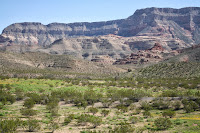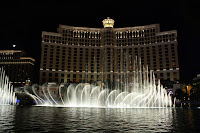Las Vegas, Believe It or Not!
 |
Approaching Hoover Dam and Lake Mead from the South,
we catch a glimpse of water in the distance. |
If an organization pays its own way to the federal government, it is allowed to remain open during the shutdown. Hoover Dam was open and absolutely crammed with visitors on Friday morning. Between Columbus Day weekend vacationers and tourists blocked from national parks by the shutdown, everyone showed up at the dam.
 |
Little grows due to lack of rainfall.
Vegas gets about four inches a year. |
We finally found a parking place in upper lot #13. Lucky! Then we walked down for views of the dam.
 |
The parking lots high above the dam off spectacular views
of the dam and the intake stations. |
"In three years if the water level continues to drop," said Andy, "it will be below the intake pipes. And no one seems to know what to do about it."
"Doesn't that mean no more electricity?" I asked.
"Yup," he answered, "and as far as I know they haven't addressed the issue. Las Vegas may be in for a sudden dearth of cheap electric. When Regan was President, he extended the three cents a kilowatt rate for 50 years, even though the issue at the time was market value. With fees, they probably pay six or seven cents a kilowatt now, while people on the East Coast are charged 22 cents."
"Interesting idea," I answered. "Imagine Vegas paying more for power!"
 |
The bathtub ring shows up as a white
line high above Lake Mead. |
We could see the bathtub ring from where water once reached in Lake Mead. Now the lake was far below maximum. "I read that it will never fill up again and never come near the spillway," said Andy. "It has to do with irrigation allocations when the dam was being built."
 |
The new bridge, built between 2005 and 2010 for security,
spans the Black Canyon and the two states. |
We walked all the way across and back. It was summer again here: baking sun, bright sky, tourists in shorts and tee-shirts. Only the mid-70 degree temperatures at noon hinted that fall had arrived.
Private tours gathered here and there with tour guides broadcasting information. We climbed the stairs back up to the car and drove to the new bridge parking lot.
 |
From the O'Callaghan-Tillman
Bridge high above Hoover
Dam, the world seems small. |
More stairs took us to the pedestrian plaza and walkway across the Mike O'Callaghan-Pat Tillman Memorial Bridge, constructed between 2005 and 2010. Named for the Nevada Congressman and Arizona football player, both of whom served in the Armed Forces, the final link of the bridge joined Nevada and Arizona in 2009. Poured in concrete sections ten feet high, the arch bridge is reinforced symmetrically with steel girders of 45 tons each that are 115 feet across. It forms a graceful white arch over Black Canyon.
On the way back to town, we stopped at the Tropicana to pick up show tickets for tonight.
 |
| We trade photo opportunities with a couple on the street. |
Across the street construction workers cleared the area in front of New York, New York. "I wonder what they are building," mused Andy.
"Central Park," I suggested. "Actually they are cleaning up the area around the Statue of Liberty from Hurricane Sandy," I said.
"Really?" he asked.
"Duh!" I don't catch Andy very often!
We walked the Strip again, taking pictures and people watching. Some of the same beggars claimed some of the same spots. I wonder if begging is territorial.
Back at Casino Royale more foreigners played their luck at the promotional machines.
Between Harrah's and the Quad, about 15 Elvis impersonators gathered in the walkway for a pep talk or rally. Not one of them looked like Elvis, even with their black wings, tight white pants and sequined jackets. They gave a little "Yea" and headed en masse to the street. We had seen several of them earlier posing for pictures with tourists in the plaza. Nearby was another tourist teaser, a middle-aged man pretending to be Cupid. Dressed only in an adult diaper with heart-shaped pasties over his nipples, he pretended to shoot women with crooked arrows. "He certainly leaves something to be desired," said Andy. I went the other way.
 |
Not for sale, Johnny Carson's
father's sedan attracts lots of interest. |
The old Imperial Palace Auto Collection is now part of the Quad. We had free passes. In a 125,000-square foot showroom, more than 250 world-class automobiles are displayed, many available for sale."
"I'm surprised how many cost under $30,000," I told Andy.
"Well," he explained, "you need to consider that originally those sold for about $2,000 each; if they need work done, it costs a fortune because of the specialty parts; and you don't know the condition of the engine for drivability."
They were all collector cars, and the display is advertised as "the world's finest classic car showroom." You can believe that or not. It's Las Vegas!
I took pictures of the old 1880's bar from Dodge City, Kansas. The sign said it was used until 1960 when the saloon was demolished.
Other photos included the following:
1. 1969 Ford Mustang 428 CJ Convertible, $95,000 asking price.
2. 1967 Rolls Royce Phantom V PV23, a black limousine owned by Red Skelton with only 47, 441 original miles, $400,0000 asking price.
3. 1957 Ford Thunderbird, built for and used by Burt Reynolds, $50,000 asking price.
4. 1966 Maserati 3500 GT Moretti Coupe, the 1966 Geneva Show Car, $650,000 asking price.
5. 1939 Chrysler Royale Sedan, owned by the father of Johnny Carson, King of Late Night. Carson learned to drive in this car and used it to take his girl to the Senior Prom. He sold it to the Auto Collection for $1.00. It is not for sale.
 |
At the Mirage the volcano erupts every
hour on the hour after darkness sets in |
We checked into Palace Station Hotel and Casino soon after 4 p.m. The "come-down" was literal and figurative. Rooms at the Rio quadrupled in cost on the weekend. We abdicated our palace on the 21st floor for servants' quarters behind the kitchen in a one-story motel wing of the Palace Station. The room was clean and faced the pool. It will do! And it gave us easier access to the Strip at night!
Our show, starring Gallagher, the fruit-smashing comedian, started at 7 p.m. at the Tropicana. Irreverent and fresh, he entertained an older audience. There was no fruit smashing (fruit smashing might have been fun), but he did admit to being 67 years old and having four heart attacks.
 |
Within five minutes the show ends,
as the eruption ceases and lava cools. |
Maybe that's why some bitterness penetrated his "Americans-can't-make-up-their-minds" jokes. "Americans aren't black or white. They are all grey and use spoon-forks," according to Gallagher.
After the Gallagher show, we headed to the Strip for the public mini-performances. The volcano at the Mirage erupted every hour on the hour. I tried to get pictures in the dark, but throngs of people crushed in from every direction.
 |
Fire spreads as the pretend lava flows
down into the lake. |
We stopped at McDonald's for burgers and then squirmed our way into the crowds at Treasure Island Casino to see the
Sirens of TI at 10 p.m. The 20-minute performance included lots of suggestive dancing by the Sirens as they lured young pirates to their doom.
 |
A cast of young performers wows
the crowd with twirls, swirls and dives. |
Three pirates actually dove overboard into the water to the delight of hundreds crowding the walkways.
 |
Las Vegas at night is as magical from high above,
as it is seductive and dangerous from below. |
By the time the Sirens disappeared and we walked back down the Strip, the volcano simmered again. We had front barrier standing room and enough light to set the camera for the explosions of fire and eruptions of light and smoke. In spite of the crowds, this time it was really fun!
Believe it or not!





























































